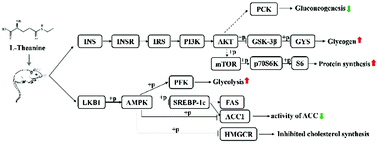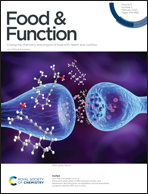l-Theanine regulates glucose, lipid, and protein metabolism via insulin and AMP-activated protein kinase signaling pathways
Abstract
L-Theanine is an important component found in tea and has positive effects on nutrient absorption and transport. However, whether L-theanine can regulate glucose, lipid, and protein metabolism remains unknown. This study aims to investigate the effects of L-theanine on glucose, lipid, and protein metabolism in male Sprague-Dawley rats and characterize the underlying mechanisms. Compared to the control group, L-theanine increased the contents of hepatic and muscle glycogen, serum total protein (TP), and albumin (Alb), lowered the serum low-density lipoprotein cholesterol (LDL-C) level, decreased the activity of acetyl-CoA carboxylase (ACC), and enhanced carnitine palmitoyl transferase-1 (CPT-1) activity in the liver. Additionally, L-theanine upregulated the mRNA expression of phosphofructokinase (PFKL), CPT-1, insulin receptor (INSR), insulin receptor substrate (IRS), and liver kinase B1 (LKB1) and downregulated the mRNA expression of phosphoenolpyruvate carboxykinase 1 (PCK1), glucose-6-phosphatase catalytic subunit (G6PC), fatty acid synthase (FAS), and 3-hydroxy-3-methylglutaryl-CoA reductase (HMGCR). Moreover, L-theanine upregulated the expression of PFKL, glycogen synthase 2 (GYS2), ribosomal protein S6 (S6), INSR, IRS, and phosphatidylinositol-4,5-bisphosphate 3-kinase (PI3K) proteins; downregulated the expression of FAS, sterol regulatory element binding protein-1c (SREBP-1c), and HMGCR proteins; enhanced the phosphorylation of the mammal target of rapamycin (mTOR), ribosomal protein S6 kinase (p70S6K), protein kinase B (AKT), and AMP-activated protein kinase (AMPK); and decreased the phosphorylation of glycogen synthase kinase 3β (GSK-3β) and ACC1. Furthermore, 100 mg kg−1L-theanine was more effective at eliciting these effects than 200 and 400 mg kg−1L-theanine. In conclusion, L-theanine can regulate glucose, lipid, and protein metabolism via insulin and AMPK and their downstream signaling pathways.



 Please wait while we load your content...
Please wait while we load your content...